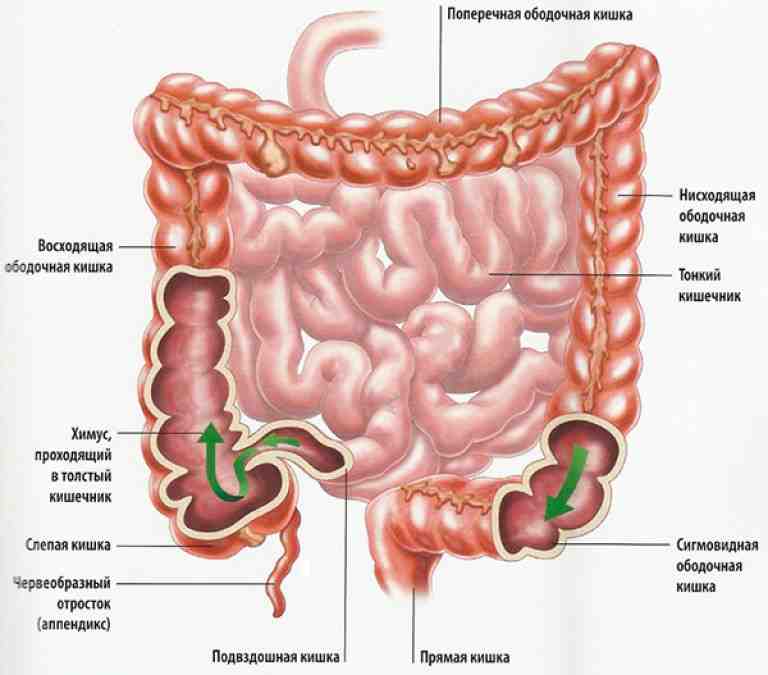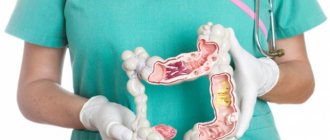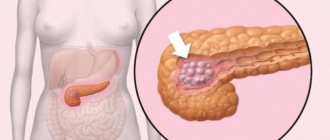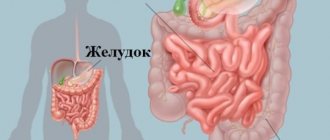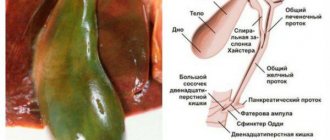Reasons for development
Atonic disorders arise primarily against the background of a group of factors that negatively affect gastrointestinal peristalsis.
This condition can be a consequence of an unhealthy lifestyle, a concomitant complication of other pathologies or taking medications, and can also develop in the form of an independent pathology.
Experts consider patients at risk for developing this pathology:
- Those who eat incorrectly, heavy and high-calorie foods with a deficiency of fiber;
- They often live in a state of stress, which overloads the activity of the nervous system structures and causes various malfunctions in various organs;
- Taking painkillers or antispasmodics for a long time;
- They live a sedentary life;
- Having intestinal infections or dysbacteriosis;
- Having a genetically determined tendency to atonic disorders;
- Smoking or abusing alcoholic beverages, which negatively affect the nervous system;
- Having helminthic infestations, parasites produce toxic waste products that negatively affect peristalsis;
- Those who abuse diarrheals and various cleansing enemas, which seriously disrupt the muscle tone of the intestinal tissues, lose the ability to work independently;
- Suffer from tumor processes in intestinal tissues;
- They use drugs from the group of opiates, which help reduce the tone of intestinal structures;
- In girls, a similar pathology can develop against the background of an unsuccessful cesarean section.
In young children, atony develops due to stress and hereditary factors, insufficient fluid intake or changes in the nature of the diet.
In elderly patients, atony may occur due to inactivity or as a result of surgical interventions.
Types of Possible Bowel Exercises
To perform therapeutic exercises, you can turn to professionals, but you are allowed to select exercises and do them yourself. Doctors recommend drinking a glass of water at room temperature before starting. Exercises include:
- diaphragm training;
- self-massage sessions;
- abdominal muscle training;
- exercises for the pelvic floor.
Return to contents
Self-massage
Massage is a combination of actions such as friction and pressure. It is aimed at activating intestinal motility. When performing self-massage, you must thoroughly wash your hands and body and take a lying position. In some cases, the procedure should be performed not on the naked body, but through fabric. The duration of the massage session should not exceed 10-15 minutes. Before starting the procedure, you need to warm your palms.
Let's look at some massage techniques:
- Using your fingertips, draw circles clockwise in the abdominal area. You need to start with light, stroking movements, gradually increasing the pressure.
- Take a lying position. As you exhale, hold your breath and with both hands make 15-20 presses on the stomach. After this, breathe in the air and relax. Repeat 3 times.
- Sit on your knees and take sharp breaths. At the same time, actively draw in your stomach. You need to start with 20 breaths and gradually increase the number to 70.
After performing such actions, a slight rumbling appears in the stomach. You should immediately drink a glass of water at room temperature, with a quarter teaspoon of salt added. After this, the urge to defecate will begin. In case of chronic constipation, massage may not bring immediate results. In this case, you should not immediately use laxatives, as the body quickly gets used to them. The best solution in such a situation would be to use folk remedies.
Exercise for atony
Atony is a disorder of the intestines, which results in the development of intoxication of the body. The main reason for it is an unbalanced diet and frequent overeating. Treating atony with laxatives is dangerous, since the body gets used to it and in the future cannot do it without medication. Massage sessions will be more beneficial. Examples of exercises:
- In a lying position, raise your legs, bend them at the knees and perform movements as if riding a bicycle. Perform 30 times.
- Take a lying position. Legs bent at the knees, pressed to the stomach. Do 20 reps.
- Twisting. To do this, lie on the floor, raise and straighten your legs. Next, throw your legs behind your head. You need to start doing the exercise carefully, gradually bending more and more.
- Lie on the floor and bend your knees. Perform knee spreads.
You need to finish the exercise by walking in place, while raising your knees high. This complex is best done in the morning, on an empty stomach. Results will be visible after at least 5-7 days of daily exercise. After improving intestinal motility, this complex can be continued once every 2-3 days. This will be a good prevention of failures in emptying.
When lowered
One of the common abdominal abnormalities is prolapse of the internal organs. The main reason is genetic inheritance. The following exercises will be useful for bowel prolapse:
- Take a lying position, bend your knees, place your arms along your body. Leaning on your hands and feet, lift your pelvis as high as possible. Stay at the top point for a couple of seconds and slowly lower to the starting position.
- Lie on the floor, arms along your body. Exhale and raise your legs straight above the floor. Hold for 5-10 seconds and return to the starting position. Repeat 15-20 times.
- Perform a scissoring motion. To do this, lie on the floor and slightly raise your straight legs. At the top point, pause and perform this movement. Repeat 15-20 times.
Symptoms of intestinal atony
One of the first characteristic signs of a lazy bowel, as atonic disorders are also called, is a prolonged digestive upset with the absence of bowel movements for 2 days.
Associated symptoms of this pathological condition are:
- Increased gas formation and flatulence, bloating;
- Sleep disturbances and constant weakness;
- The dense nature of feces;
- Anemia;
- Marbled skin tone, pallor.
If such symptoms are detected, it is necessary to urgently consult a specialist, because disturbances in intestinal activity are fraught with dangerous complications.
Exercises for bowel function
The problem of constipation is becoming more and more common these days. When treating it, intestinal gymnastics is of great importance. Therapeutic exercise stimulates intestinal motility, thereby helping food move through. Of course, medications give immediate results, but at the same time, not all of them eliminate the very cause of constipation. Properly selected physical exercises will help tone the intestines and relax the tissues.
Diagnostics
This disease can be diagnosed by a specialist in the field of proctology or gastroenterology, based on examination data, collected anamnestic information and laboratory results.
It is much more difficult to determine the true cause that provoked the development of atonic disorders. For this purpose, instrumental and laboratory diagnostics are carried out, including examination of stool for dysbacteriosis and helminths, and a coprogram.
A blood test is prescribed to determine the level of thyroid hormones, because a deficiency of thyroid hormones leads to a decrease in intestinal tone.
Patients are prescribed radiography using the barium passage method, which allows an accurate assessment of the motility of small intestinal structures. Irrigoscopy may be required to exclude organic lesions of the colon as possible causes.
Colonoscopic examination is considered quite informative, as it visualizes the state of intestinal structures and allows one to differentiate atony from other intestinal pathologies. If necessary, a biopsy and histology of intestinal tissues are prescribed.
If the diagnostic measures taken do not give the desired result, then it is necessary to consult with specialists in other fields, for example, a psychologist or neurologist, psychotherapist, because decreased intestinal tone is often caused by psychogenic factors.
Other methods of influence
Yoga Shank Prakshalana
Shank Prakshalana translates to “cleansing the sink.” Gymnastics consists of the following actions:
- Stand straight, the distance between your legs is 15 cm. Tighten your knees, pull your stomach in as much as possible. The gluteal muscles should be tense. Straighten your back and raise your arms, palms up. Cross your thumbs. The neck and face should be relaxed. Inhale and rise onto your toes. At the same time, the whole body should remain straight. As you exhale, lower yourself onto your heels.
- The starting position is the same. Breathe freely and perform smooth bends to the right and left. In this case, the lower part of the body must be fixed.
- Stand straight, feet shoulder-width apart. Raise one arm at an angle of 90 degrees to the body, and bend the other so that the fingers touch the opposite collarbone. Fix the lower part of the body, and twist the upper part. At the same time, try to move your straight arm as far behind your back as possible.
- Lie down on the floor. Lean on your palms and toes, while raising your torso. The distance between the legs should be 30-35 cm. In this position, you need to twist the upper body and head until both heels are visible. Without stopping, make a turn in the other direction.
- Sit down. Place one leg bent at the knee on the floor and keep the other straight. Perform turns towards the raised leg. Next, changing legs, continue twisting.
The complex should be done in the morning, on an empty stomach. Duration - 1 hour. Before each exercise you need to drink a glass of salted water. The essence of yoga is that the exercises push the liquid you drink through the gastrointestinal tract. As a result, such therapeutic exercise helps with constipation and promotes bowel movements.
Belly dance
The benefits of belly dancing cannot be overestimated. It not only helps strengthen your posture and shoulder girdle, but also massages your internal organs. This property helps to get rid of a number of chronic diseases. Dance steps help to resolve adhesions and congestion in the internal organs. Daily belly dancing classes will help get rid of the problem of constipation and normalize digestion. There are no contraindications to them.
Treatment in adults and children
As with many other pathologies, therapy for atony requires an integrated approach and is aimed at eliminating the provoking factor and negative effects on intestinal motility. For atony it is used:
- Drug therapy;
- Physiotherapy;
- Diet therapy;
- Traditional medicine recipes;
- Normalization and correction of habits, lifestyle, etc.
With the right combination of these techniques, patients can achieve good results and avoid relapses of atony, significantly improving gastrointestinal motility.
Drugs
In the treatment of atony, the leading place is given to a drug from the group of prokinetics, which improve intestinal motility and increase the tone of the gastrointestinal tract. Drugs from the category of choleretic agents and cholinesterase inhibitors are also prescribed.
Distigmine bromide, which stimulates glandular activity and increases peristalsis, is considered an effective remedy for atony. It is usually used for chronic constipation.
Also, for atony, neostigmine methyl sulfate is widely used, which increases the tone of the muscle tissue of the gastrointestinal tract.
Trimedat
The drug Trimedat belongs to the group of medications that regulate gastrointestinal motility. Trimedat acts gently throughout all intestinal sections, enhancing peristalsis, promoting bowel movements and reducing esophageal sphincter pressure.
It is prescribed for lazy bowels to normalize bowel movements. The medication is effective for the treatment and prevention of atony in people who already have a history of atonic intestinal disorders.
The drug restores the full activity of intestinal motility in various pathologies of the gastrointestinal tract.
Contraindicated in children under 3 years of age and persons with hypersensitivity to the drug. Allergic reactions in the form of skin rashes may occur while taking it. Not recommended for pregnant and lactating women.
Prozerin
The drug Prozerin belongs to acetylcholinesterase inhibitors. The drug effectively improves neuromuscular impulse transmission, increases muscle tone of the intestinal walls, helping feces move through.
Most often prescribed in injection form. Contraindicated in acute intoxication conditions and pathologies of the thyroid gland, benign prostatic hyperplasia and myocardial pathologies, ulcerative processes, etc.
While using the drug, patients are likely to experience increased salivation, headaches and arthralgia, shortness of breath and frequent urination.
The drug is usually used in hospital treatment when other medications are useless. The drug is widely known and has many reviews.
Oleg, Ekaterinburg:
When I couldn’t go to the toilet for several days in a row, I didn’t take my condition very seriously. But within a day, in addition to constipation, severe pain in the intestines began to bother me. I went to see a therapist and was prescribed some laxatives and Proserin. After taking the Proserina tablets, I only felt worse. My stomach was swollen, I had a headache, and I felt short of breath. Then I read the instructions, it turns out that these pills have the following side effects. After a course of complex treatment, the intestinal problems were successfully eliminated, but after that I try not to take Proserin anymore, too many unpleasant reactions occur after it.
Irina, Moscow:
I had the opportunity to become acquainted with the drug Proserin in the hospital, where I was injected with it for intestinal atony. The drug helps, but it causes a lot of side effects. I felt nauseous and dizzy throughout the course. With a painkiller, this injection is much easier to tolerate, and it helps a lot; intestinal motility was quickly restored. But if possible, it is better to replace it with a drug with fewer side effects.
Laxatives
Laxatives are prescribed for atony only in the first few days in order to normalize the bowel movements. Laxatives do not treat the cause of stagnation of feces, but only temporarily eliminate their consequences.
Laxatives of various groups can be used:
- Containing lactulose, for example, Prelax, Fortrans, Duphalac or Normolakt. These agents stimulate intestinal peristalsis, soften stool and stimulate motility. A pronounced effect is observed 3-6 hours after administration.
- Secretory drugs of plant or synthetic origin. Herbal products include products with leaves of the senna herb like Regulax, Senade or Antrasennin, with vegetable oils and other medicinal raw materials.
- Natural laxatives like bran and cabbage, which increase the volume of feces, which stimulates intestinal peristalsis and facilitates the movement of masses. Unlike medications, such drugs do not cause addiction or adverse reactions, but naturally normalize peristalsis and motility.
You need to be extremely careful when taking laxatives, because sometimes excessive abuse of these medications can provoke serious disturbances in peristalsis and motility of intestinal muscle tissue.
Cleansing enema
A cleansing enema will also help alleviate the condition of a lazy intestine, but its volume should not exceed 500 ml. It is recommended to carry out a cleansing enema in the evening.
Water introduced into the anus will soften the stool and help it pass painlessly from the rectum. For administration, you need to use ordinary warm water, because when cold liquid is introduced into the intestines, spasms of muscle tissue may occur.
Before going to bed, you can also do enemas with oil; they normalize bowel movements, relieve the feeling of heaviness and normalize intestinal motility. The volume of such an enema should be a maximum of 150 ml, the procedures are done for three to five days in a row, after bowel movements are normalized, the treatment is stopped.
Diet
Diet therapy for atony is aimed at consuming foods that facilitate the passage of feces through the intestines. These include:
- Dairy products and bran;
- Dried apricots and figs;
- Greens, fruits and fresh vegetables;
- Kelp (algae) and freshly squeezed juices from vegetables, fruits such as apricots or plums;
- Millet and buckwheat groats;
- Lean meat and black bread.
It is necessary to exclude from the diet any unhealthy foods such as chocolate and cocoa, fatty broths and lard, smoked meats and marinades, canned food, etc.
Folk remedies
Often, for atony, traditional methods of treatment are used, which are only additional in nature and cannot be used as primary therapy.
There are many recipes for preparing healing decoctions and infusions that help solve the problem of a lazy intestine:
- Honey with aloe. To prepare the medicine, take 4-5 leaves of the plant, peel and crush them. Half a glass of honey should be heated to about 40°C and mixed with aloe. You need to infuse the mixture for a day, and then take a heated spoon daily.
- Milk with mint. For this drug, add half a spoon of honey and mint juice to milk (250 ml). The drink is mixed and drunk twice a day before meals, a quarter of an hour.
- Bran with milk. Pour 2 large spoons of bran into a glass of warm milk, leave for half an hour and take on an empty stomach in the morning. The duration of therapy is one and a half weeks.
- Senna. In a glass of hot water you need to steam a large spoonful of senna and boil over a fire for a quarter of an hour, then leave for another hour. You need to take the medicine in a large spoon 3 times a day.
- Castor oil. Castor oil is taken in its pure form for intestinal atony, a large spoon once a day. The duration of the course is a maximum of 3 days.
Folk remedies can be used in the treatment of intestinal atony only after consultation with a gastroenterologist or proctologist.
Exercise therapy
To restore intestinal activity, patients are recommended to undergo therapeutic exercises, which strengthen the abdominal muscles and improve the functioning of all intestinal sections. A set of exercises usually includes:
- Raising legs alternately from a lying position;
- Swing your legs alternately from a position on all fours;
- Classic abdominal swing;
- Exercise "bicycle";
- Lying on your back, you need to pull your knees to your chest, and then return to your original position.
Exercise therapy is permitted only in the absence of exacerbations or complications of the pathology. If there is internal bleeding, intoxication or inflammatory processes, you should refrain from any exercise.
In other cases, proper exercise helps improve the passage of excrement through the intestinal canals and increases peristalsis.
Treatment

In cases where intestinal atony is caused by other factors (infection, nervous disorders, tumors), then the underlying disease is eliminated.
For atonic and alimentary constipation, treatment begins with normalizing the diet. The following products are required:
- Vegetables and fruits rich in fiber; cabbage, beets, cucumbers, apples and the like;
- Dried fruits and compotes made from them;
- Porridge.
Minimize consumption:
- Fat;
- Fried;
- Baking;
- Sweets and confectionery.
Control your diet, avoiding long breaks and overeating.
Normalize physical activity: gymnastics, walking. If this is not possible for any reason, perform special exercises for the abdominal and pelvic floor muscles, which can be done even while lying down.
If the measures taken are not enough, they resort to drug treatment. Various stimulants and laxatives are prescribed:
- "Regulax";
- "Metoclopramide";
- "Espumizan";
- Enzyme preparations: “Pancreatin”, “Mezim”;
- "Amiridin";
- "Prozerin";
- Rectal suppositories; “Glycerin”, with cocoa butter and belladonna.
It is not recommended to take laxatives such as senna leaves, castor oil, or magnesia. They can be used as a one-time measure if defecation is difficult, but not as a permanent remedy.
There are also folk remedies that increase intestinal tone:
- Grapefruit juice;
- Flax seed decoction;
- Sea kale;
- Infusion of dill seeds;
- Sequence grass;
- Thyme herb;
- Buckthorn bark is brittle;
- Rhizomes of calamus.
These drugs act more gently than pharmacopoeial drugs, and it is recommended to start treatment with them.
Bladder atony can also be treated with a special diet and exercise. It is recommended to exclude irritating foods - tea, coffee, spicy and salty foods; develop urination on a schedule. In some cases, they resort to drug treatment or surgical intervention (for example, in case of violation of the anatomical location of organs).
Consequences
A prolonged state of atony without treatment increases the risk of many diseases. These include:
- malignant neoplasms of the abdominal cavity (intestines, liver, stomach, uterus and ovaries in women, prostate and bladder in men, pancreas);
- hemorrhoidal bleeding;
- Iron-deficiency anemia;
- vitamin deficiency with impaired functioning of the gonads.
Immunity sharply decreases, so patients often suffer from respiratory infections, chronic cystitis, men suffer from prostatitis, women suffer from inflammation of the uterus and appendages.
Lack of smooth muscle tone (striated) intestinal muscles can lead to constipation and difficulty defecating. Such symptoms are present in intestinal atony and require treatment.
